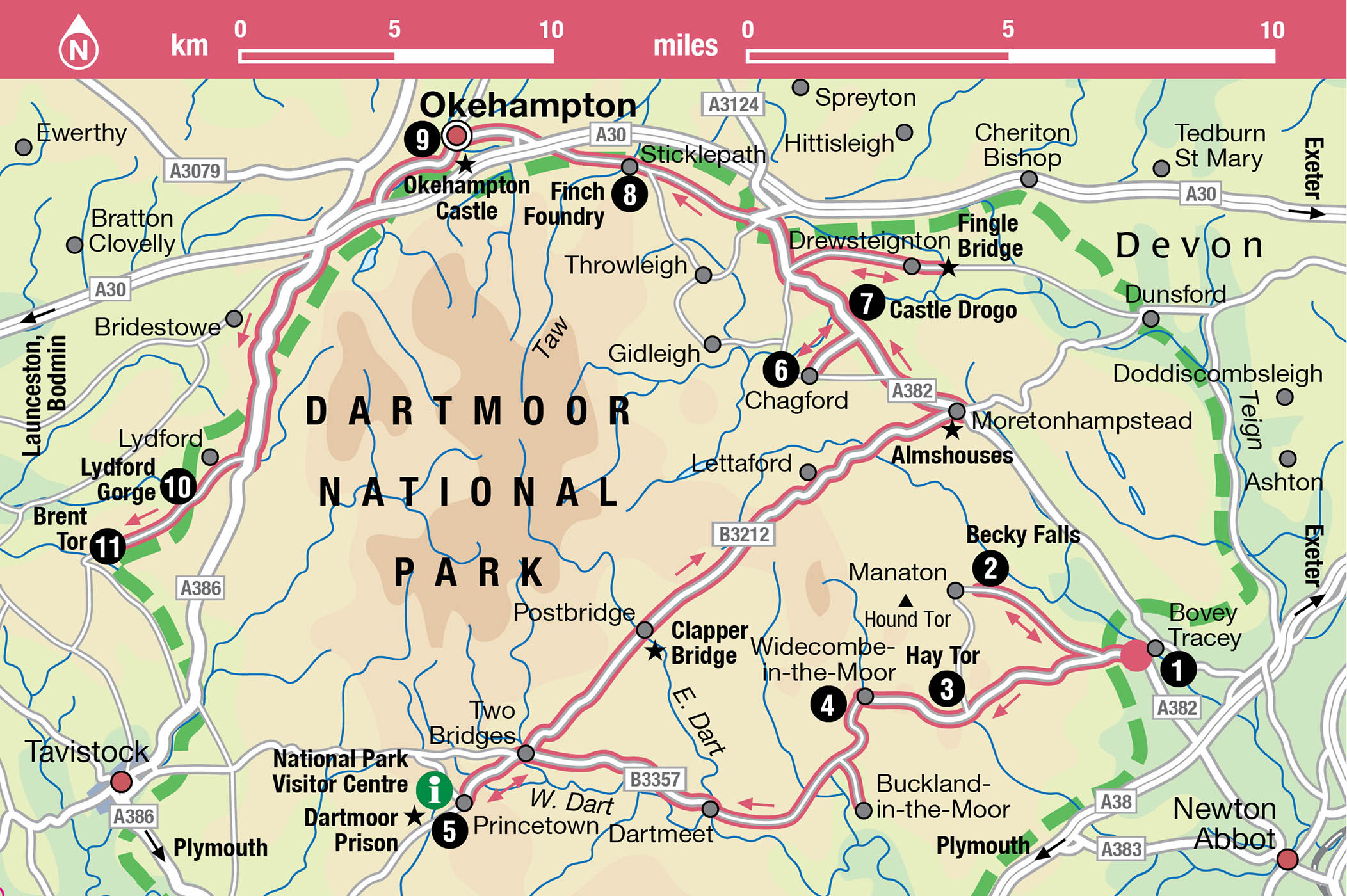Highlights
Dartmoor National Park covers some 365 sq miles (945 sq km) of south-central Devon. Although the moor is governed by the park authority, the land is still largely in private hands. Prince Charles, title holder of the Duchy of Cornwall, is the largest single landowner. Look out for the Dartmoor ponies who have roamed here freely since the 10th century.
Reaching 2,037ft (621m), the moor is the highest land in southern England. Around half of it is open moorland, and the rest (particularly on the eastern side) is steep wooded valleys with secluded villages.
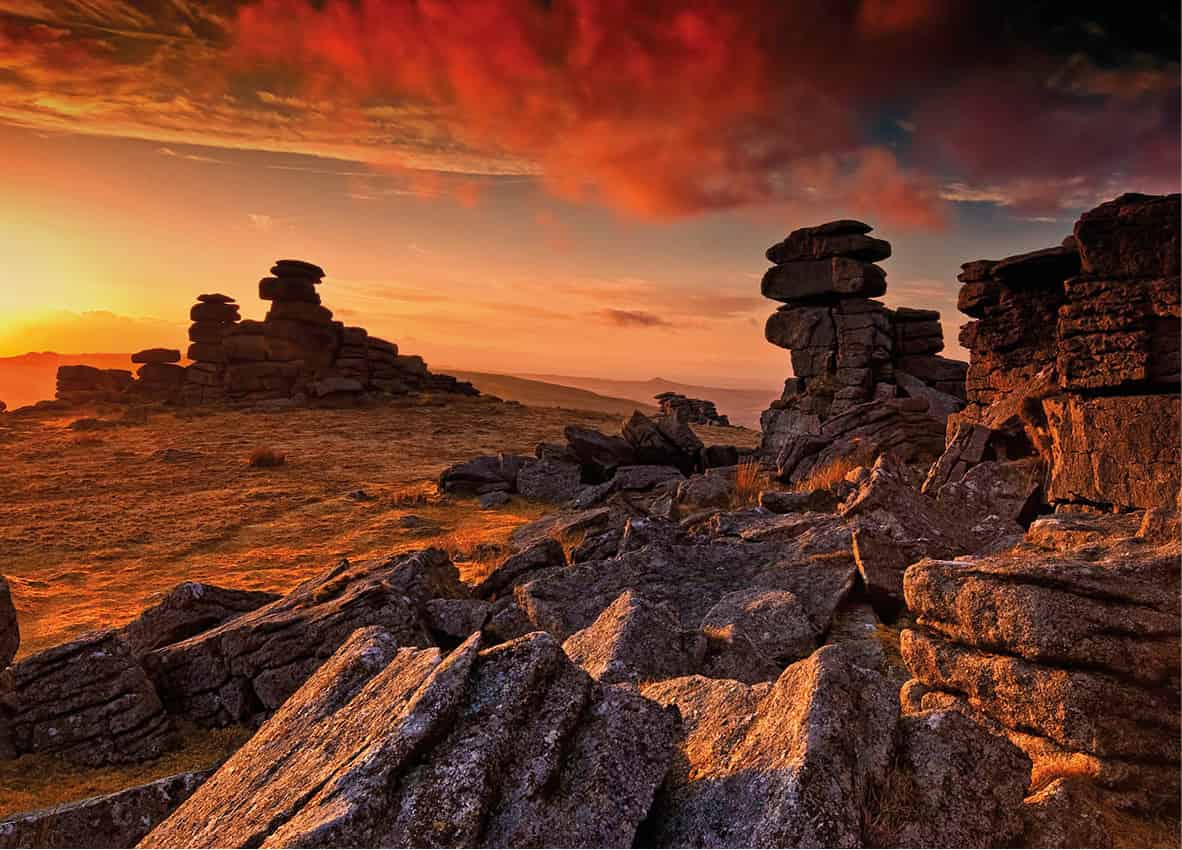
Sunset over Staple Tor.
Getty Images
Dartmoor generates a climate of its own. In the distant past this climate was kinder, and the high moor was more heavily cultivated and populated than it is today. The first people worked the moor 10,000 years ago, and until 7,000 years ago it was mostly wooded. But as the climate worsened, so the population left their settlements in search of easier ground lower down. As a result, Dartmoor has a wealth of around 2,000 Bronze Age sites – hut circles, tombs and ceremonial stones – dating from around 4,000BC. Mixed in with Bronze Age remnants are signs of more recent industry, in particular the mining of tin, granite and copper from the 12th to 19th centuries.
Tin mining – largely tin streaming in the open river beds – was a boom industry, and the Dartmoor miners were granted special exemption from the nation’s taxes. Although they never numbered more than a few hundred, they made a powerful group with their own laws, their own parliament (which met at Crockern Tor) and their own judiciary and prison at Lydford. Their contribution to the nation’s coffers was made at the strategically placed stannary towns of Ashburton, Chagford, Plympton and Tavistock; here the tin was weighed and duty paid.
Strange legends and traditions persist, including the pastime of letterboxing, a sort of moorland treasure hunt (for more information, click here); and as recently as the mid-19th century, if you could build a house on Dartmoor between sunrise and sunset, it and the land were yours.
Since Napoleonic times areas have been assigned for military use. On firing days warning flags fly around restricted areas, and post offices and visitor centres display details of firing schedules.
National Trust
If you are keen on visiting stately homes and, especially, gardens, it is worth considering becoming a National Trust member. Many of the houses and gardens described en route (those marked NT), and more besides, are in the care of the Trust. You could soon recoup your membership fee as well as contributing to the upkeep not only of the properties, but of much of the coast that is also under the Trust’s protection.
Contact them at tel: 0844-800 1895, or www.nationaltrust.org.uk, or fill in a form and join on the spot when visiting any of their properties.
Bovey Tracey
The eastern gateway to the moor is Bovey Tracey 1 [map], a pleasant small town with a long main street heading up the hillside. It was the scene of an undignified fracas during the Civil War when Royalists were surprised at cards, but managed to escape by scattering their stake money, which proved too much of a temptation for Cromwell’s impoverished troops.
From Bovey head west towards Widecombe. Just outside town is Parke House, headquarters of the Dartmoor National Park Authority. At this point a short diversion northwest towards Manaton brings you to Becky Falls 2 [map] (www.beckyfalls.com), more a dramatic series of tumbles than a waterfall, with tearoom and nature trails in very pleasant woodland.
Bovey Crafts
Bovey’s solid granite architecture is unremarkable, but it does have two shopping highlights. In a small industrial estate on the Exeter side of town The House of Marbles and Teign Valley Glassworks has glass and pottery in a synthesis of museum and retailing, with some glass-blowing on site. Further towards the centre of town is the Devon Guild of Craftsmen, located in an appealing old riverside ‘mill’ (actually a stable block with a waterwheel to pump water for the horses), with exhibition space on the first floor. The range and quality of the Devon Guild’s members is extremely high, but prices can be steep; www.crafts.org.uk.
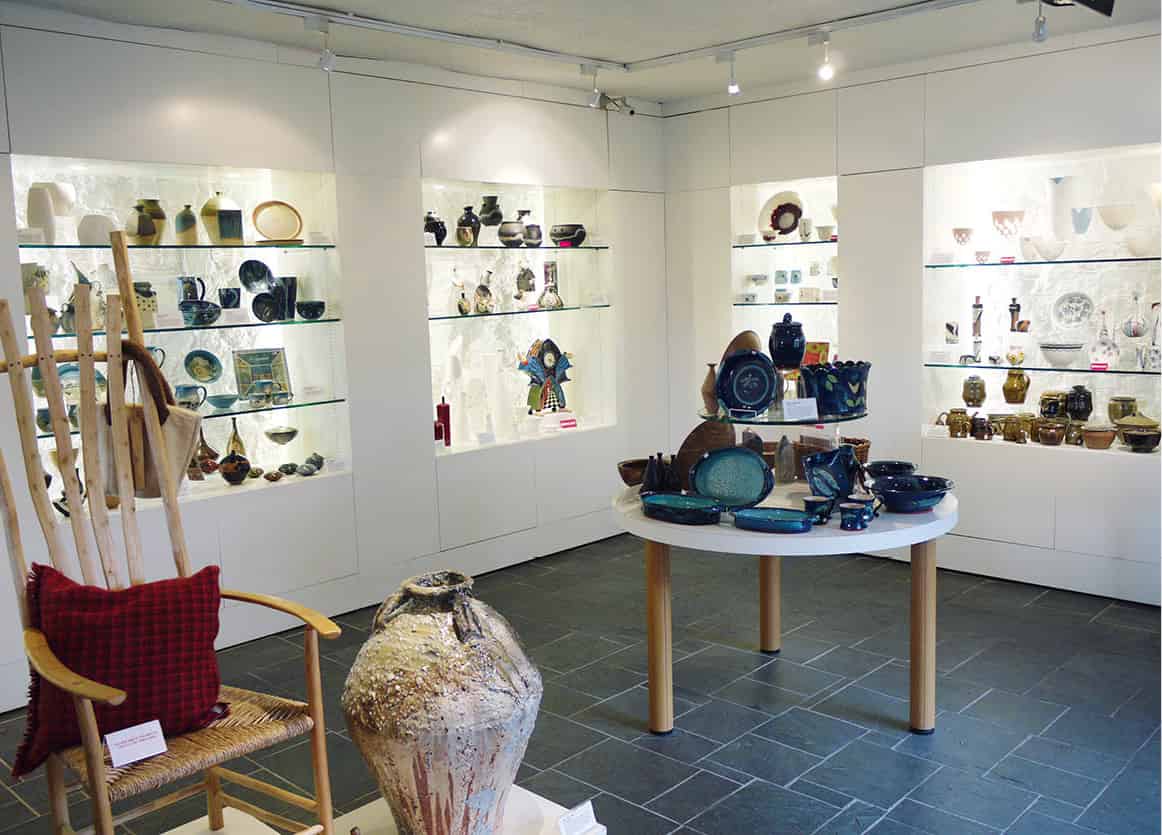
Pottery and glass items for sale.
Tom Smyth
To Widecombe
Back on the Widecombe road, the climb is steep, and the moor opens out at the popular Hay Tor 3 [map] (1,491ft/450m), with far-reaching views. It is a short and relatively easy walk from the road to the great granite tor (rock). Running along the back shoulder of the hill is the Granite Tramway, a track made from granite, with points, that was used to transport granite from the quarry in the hillside 10 miles (16km) down to the Stover canal. To the northwest is Hound Tor, and in the valley on the far side are evident remains of a medieval village among the bracken.
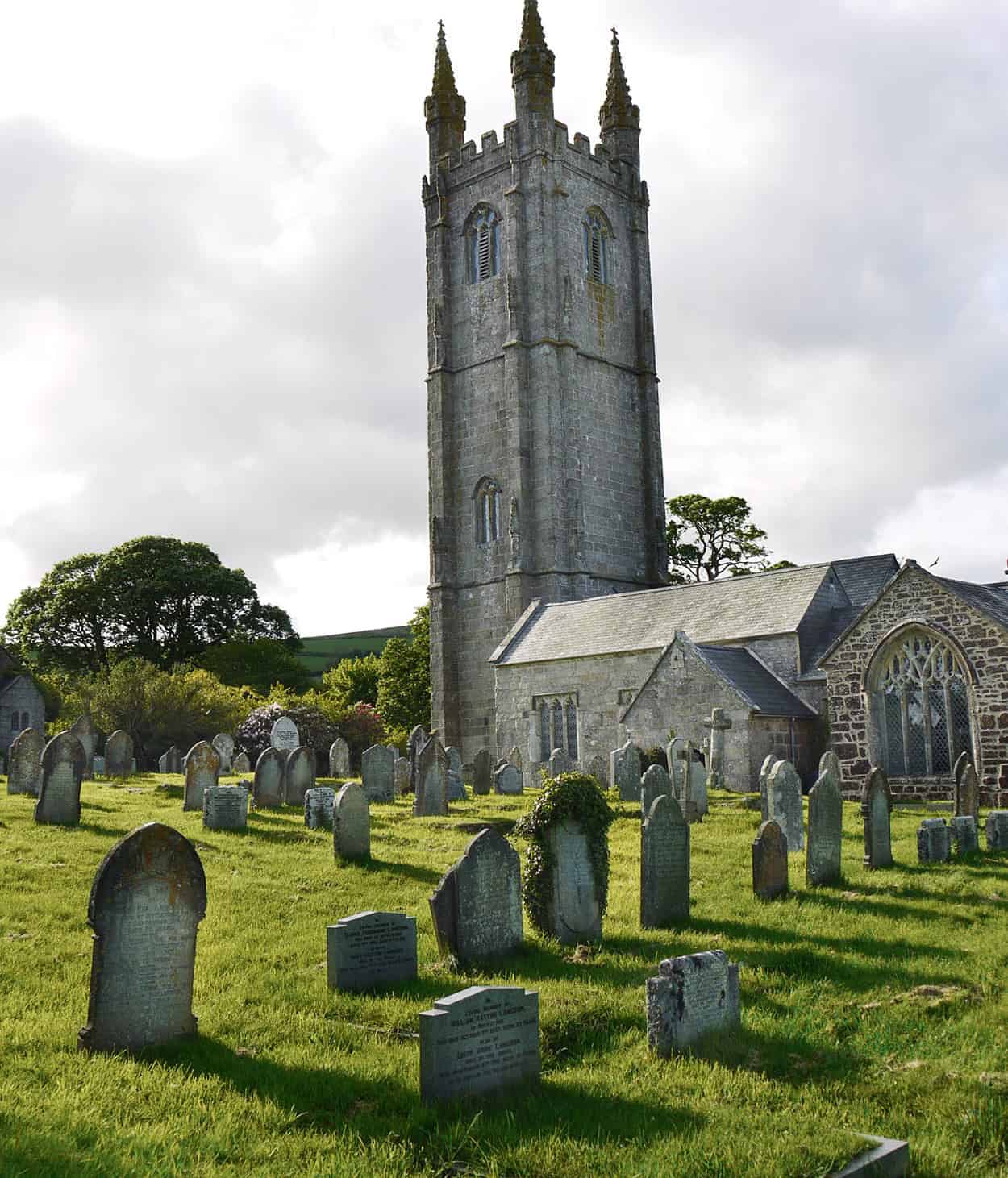
St Pancras in Widecombe, the Cathedral of the Moor.
Tom Smyth
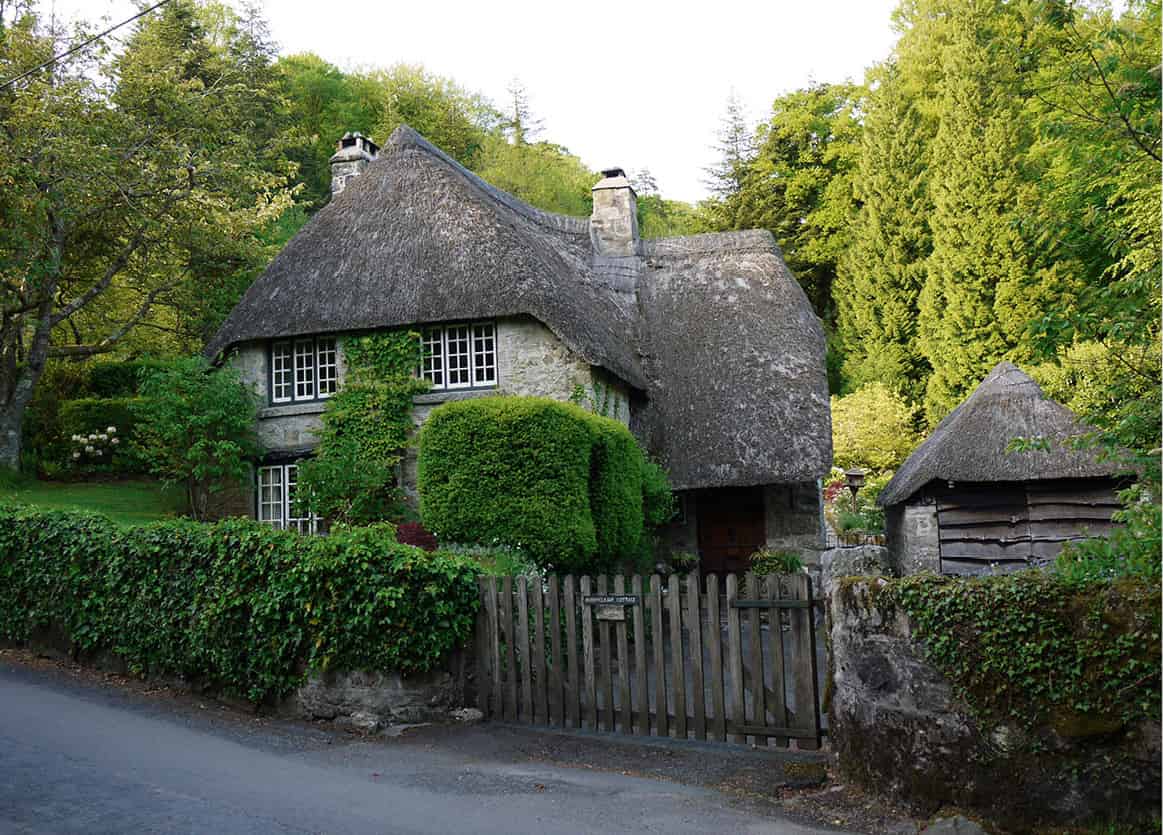
A high point of Devon thatch at Buckland-in-the-Moor.
Tom Smyth
Widecombe-in-the-Moor 4 [map] is a small, captivating place superbly situated in a deep trough but still 800ft (240m) above sea level. Its outsized church of St Pancras is known as the Cathedral of the Moor. The town has become a tourist attraction thanks to the song about its annual fair. It dates from the 1860s, and was intended to attract ‘Uncle Tom Cobley and all’ away from similar events elsewhere. Such is the power of advertising that the September fair remains a major celebration, with country skills and livestock competitions.
Down narrow lanes south of Widecombe are two other pretty Dartmoor villages. Buckland-in-the-Moor, al-though scattered around a wooded hillside, has one of the most photographed groups of thatched cottages in Devon. The small church has an unusual clock face with the 12 letters my dear mother instead of numerals. Further south is Holne, birthplace of The Water Babies author Charles Kingsley. The 14th-century Church House Inn is one of Dartmoor’s most characterful.
From Widecombe the main road heads west through the surprisingly popular spot of Dartmeet and thence up to Two Bridges. Both locations are little more than their names suggest: the former is the meeting place for the East and West Dart rivers, and the latter is a hotel next to old and new river crossings.
Princetown
Princetown 5 [map], the highest and bleakest settlement on Dartmoor, shelters beneath the huge transmitter mast on North Hessary Tor. It has the grim aspect of a frontier town, and in bad weather is regularly cut off. Amazingly, a railway reached here from Plymouth in 1883, but was closed in 1956.
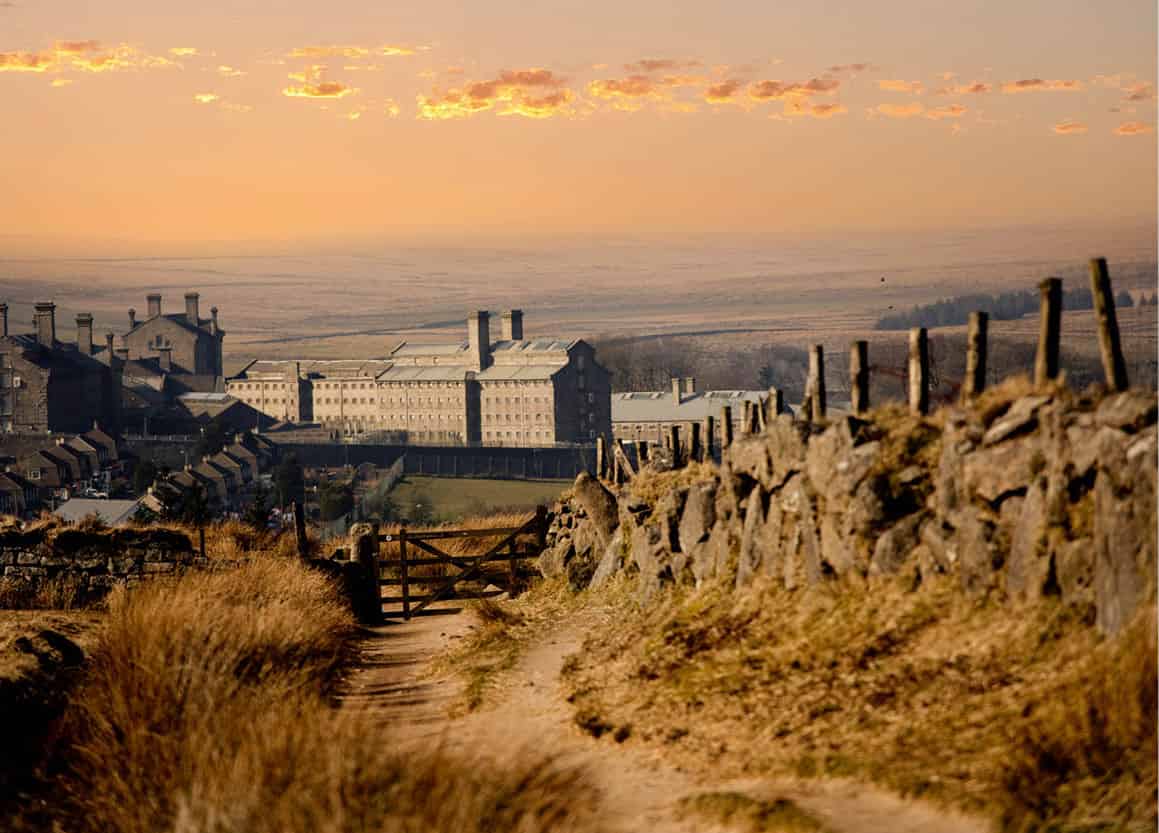
Beyond the lovely country lane lies eerie and impenetrable Dartmoor Prison, whose museum gives a glimpse of life inside.
iStock
After the mast, the town’s landmark is Dartmoor Prison, built in 1806 for French prisoners of the Napoleonic Wars. After the introduction of deportation to the colonies it stood empty for many years, but today it functions as one of Britain’s maximumsecurity jails. A small museum (open daily) charts its history, and has some items confiscated over the years. Its manager must be the only museum curator in the country liable to be called away in the event of prison riots.
Stories and legends
By Princetown’s central crossroads is the National Park Visitor Centre (tel: 01822-890 414; www.dartmoor.gov.uk; Mar–Oct daily 10am–5pm, Nov–Feb Tue, Thu–Sun 10.30am–3.30pm, free) with beautiful displays on Dartmoor’s history and wildlife and insights into some of its legends. This is also the place to find out about the schedule of guided walks.
Across the road you’ll find the ancient Plume of Feathers, the oldest building in the area (1795). During a refreshment stop here, you can ponder the story of the fearful winter wayfarer who opened a box seat in his room to discover the body of a man. Murder was assumed, until the landlord confessed that the body was that of his father, and he was only being stored there while the ground remained too hard to be dug.
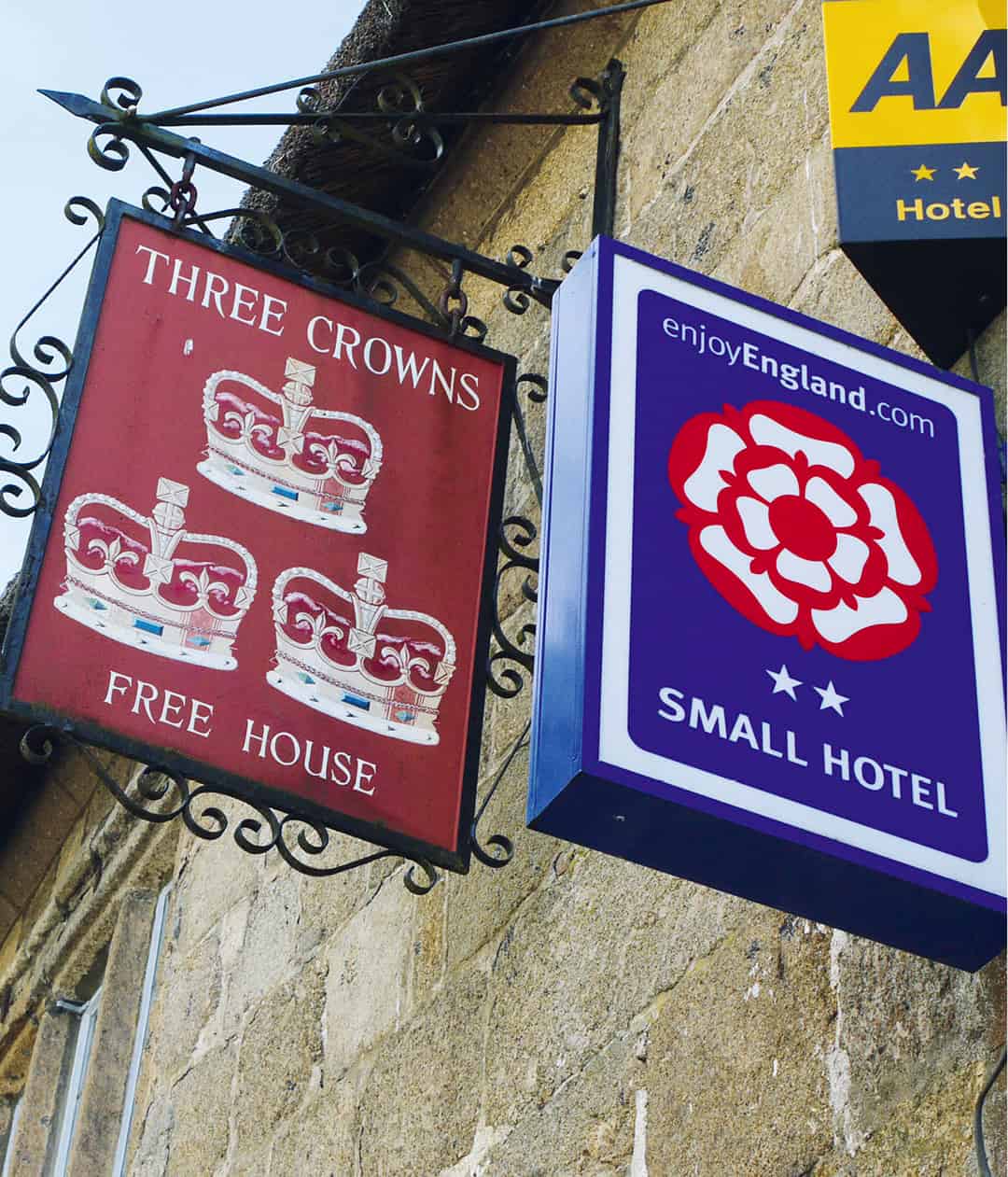
The Three Crowns at Chagford is supposedly haunted by a Royalist poet who died in its porch.
Tom Smyth
Letterboxing
Dartmoor has something of a unique activity in letterboxing – an outdoor pursuit with similarities to orienteering, which older kids will enjoy. Some 2,000 ‘letterboxes’, usually tin boxes, are hidden in remote locations over the moor. Walkers search out a particular letterbox (having first got the location from another letterboxer, or the letterboxing newsletter), stamp their own book with the letterbox’s stamp, and then head on for the next. This occupation is so popular that over 1,000 letterboxers take to the moor every weekend. Letterboxing began on Dartmoor but is now popular in areas all over the world. For information check out www.letterboxingondartmoor.co.uk.
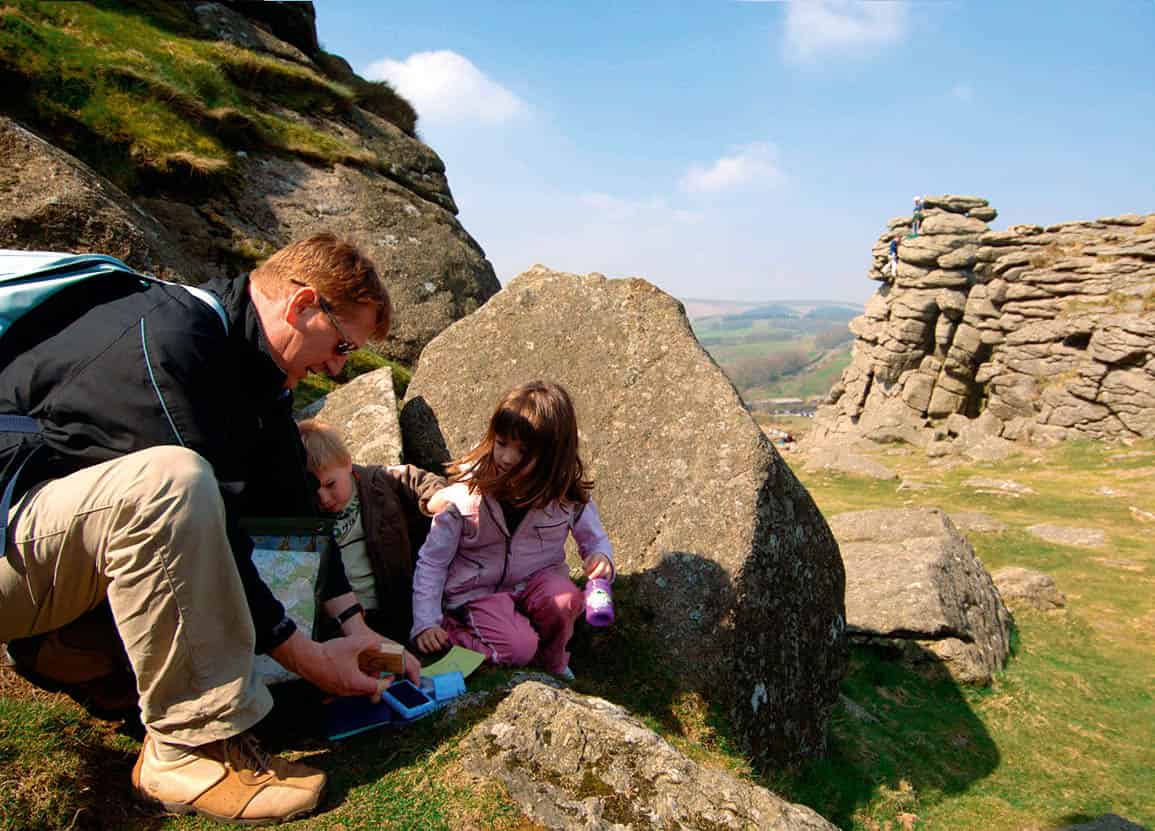
Letterboxers get a stamp to show they passed this way.
Alamy
From Princetown return northeast to Two Bridges and then north for Postbridge. This straight stretch of road has fuelled one of Dartmoor’s best-known legends. A pair of hairy hands is reputed to have caused several accidents by appearing from nowhere and wresting control of the steering wheel. The 14th-century bridge at Postbridge, made from vast granite slabs, is the best example of a traditional local ‘clapper’ bridge. The moor softens as the road continues northeast to Moretonhampstead, an attractive small town blighted by the five roads that meet in the town centre. Moreton has become something of an arts and crafts centre, with a number of studios and potteries. On the way out of town are Moreton’s almshouses, dating from 1637 and the property of the National Trust.
Chagford
Chagford 6 [map] lies a short distance northwest, off the A382 to Okehampton. Its stannary past has left the town looking remarkably elegant, gathered around a small market square at the centre of which is the six-sided and spired Market House (1862), known locally as the Pepperpot. Shopping around the square is a mixture of hardware and arts and crafts. Off the top left-hand corner of the square is the 16th-century Three Crowns hotel, which is supposedly haunted by the Cavalier poet, Sydney Godolphin, who was fatally shot here.
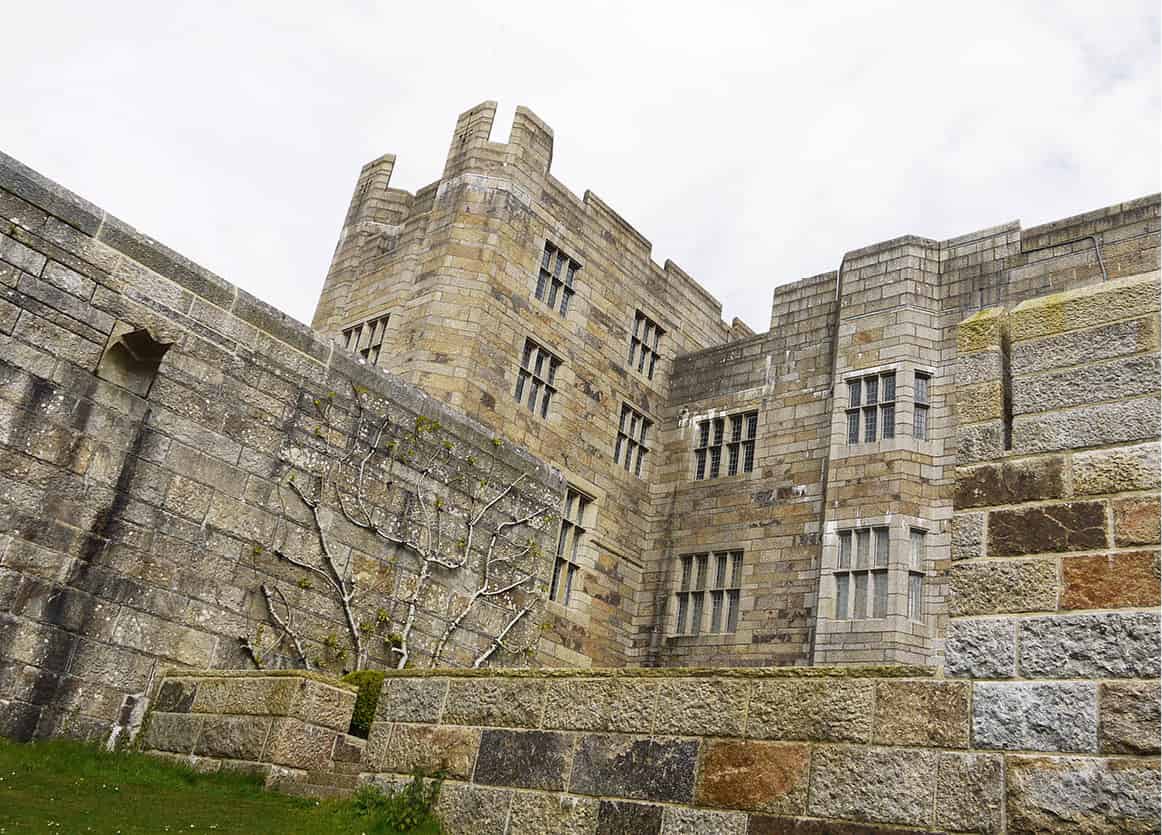
Hilltop Castle Drogo can experience extreme weather conditions.
Tom Smyth
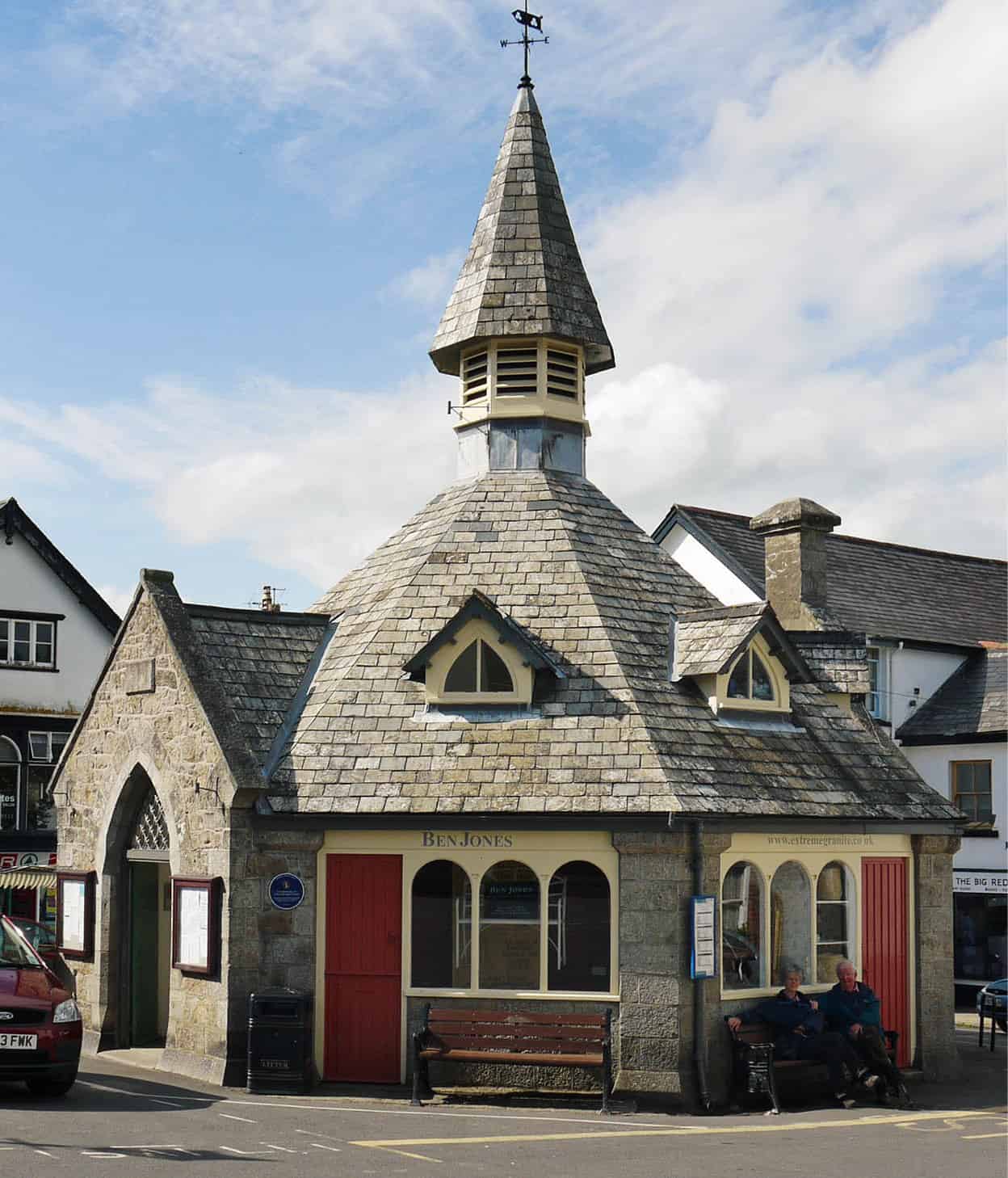
The old market hall, Chagford.
Tom Smyth
Back on the road to Okehampton, the silhouette of Castle Drogo 7 [map] (NT; tel: 01647-433 306; Mar–Oct 11am–5pm, Nov–mid-Dec Sat–Sun 11am–4pm) looms ahead up on the hill to the right, although the journey to its door is about 3 miles (4.8km) through narrow lanes. This dramatic situation was chosen by one Julius Drewe while picnicking here with his family. The last castle to be built in England, in 1910, it was designed by Edwin Lutyens and has plenty of features, including tapestries from the 17th century. At present covered in scaffolding, the building is undergoing major refurbishment due to finish in 2017 but remains open to the public and features innovative new displays.
Outside are terraced gardens and woodland walks down into the Teign gorge. Particularly worthwhile is the walk to Fingle Bridge, a 400-year-old footbridge of some charm a couple of miles upstream, which can also be reached by road via the pretty hilltop village of Drewsteignton.
Just before Okehampton, in Sticklepath, is the Finch Foundry 8 [map] (NT; tel: 01837-840 046; mid-Mar–Oct daily 11am–5pm), remarkable because it was still manufacturing edged tools by hand as recently as 1960, using hammers, shears and grindstones powered by waterwheels – all still in working order. Local farmers swear by their Finch tools.
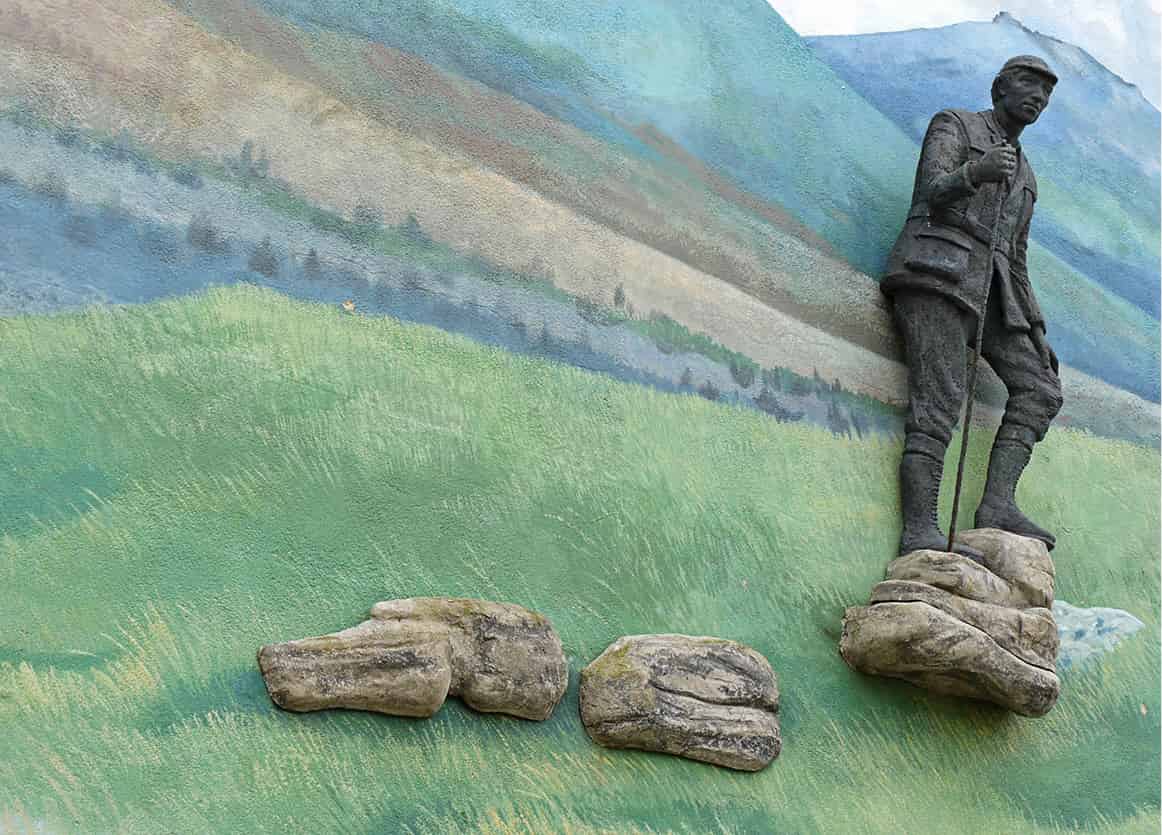
Mural in Okehampton depicting a man of the moor.
Tom Smyth
Okehampton
The A30 sweeps past the market town of Okehampton 9 [map], cutting it off from the moor to which it spiritually belongs. The town is a matter-of-fact sort of place, and is particularly well served by the Museum of Dartmoor Life (www.museumofdartmoorlife.org.uk; Easter–Oct Mon–Fri 10.15am–4.15pm, Sat 10.15am–1pm, shorter hours in winter), found through an arch off the main street. The museum gives detailed insights into the archaeology and sociology of the moor, with good use of aerial photography.
Okehampton’s Castle (Apr–Jun, Sep 10am–5pm, Jul–Aug 10am–6pm) has been a ruin since Henry VIII seized it in 1538, but what it lacks in roof it makes up for in location, on a hilltop in a wooded valley half a mile behind the museum, and with a riverside picnic area below. The castle was built in 1068 by Baldwin de Brionne, the first sheriff of Devon.
Gorge and waterfall
Return to the A30 and then take the moor-skirting A386 south. Half way to Tavistock, off to the right, is the village of Lydford, a former administrative centre of the Royal Forest of Dartmoor whose castle is actually just a prison keep. The earth thrown up around it gives it the appearance of a castle.
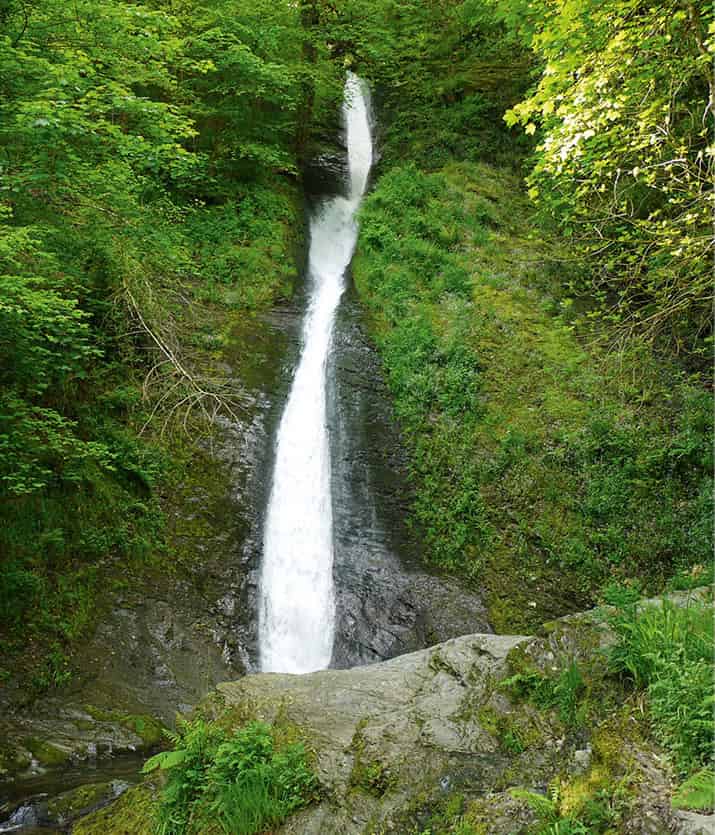
The White Lady Waterfall in the scenic Lydford Gorge.
Tom Smyth
The scenic Lydford Gorge ) [map] (NT; tel: 01822-820320; mid-Mar–Sept daily 10am–5pm, Oct 10am–4pm, Nov–Dec Sat–Sun 11am–3.30pm) is just beyond the village. The river Lyd thunders through it, shadowed by an alarming walkway. In more gentle scenery downstream the river is joined by the elegant White Lady Waterfall, which is actually more a slide than a fall.
The last stop on this route, Brent Tor ! [map], can be reached either via back lanes from Lydford or by returning to the A386. From here it is a short distance to Tavistock (for more information, click here).

Gidleigh Park dessert.
UK Country House Hotels
Eating Out
Eating Out
Widecombe-in-the-Moor
Rugglestone Inn
tel: 01364-621 327; www.rugglestoneinn.co.uk; daily lunch and dinner.
Sample good home-cooked fare washed down by a real ale or local farm cider at this pretty stone pub near the centre of Widecombe. It’s wise to book in high season. £
Bovey Tracey
The Old Pottery
The House of Marbles; tel: 01626-835 285; www.houseofmarbles.com; Mon–Sat 9am–4.30pm, Sun 10am–4.30pm.
Located in The House of Marbles and Teign Valley Glassworks, this locals’ favourite serves excellent brunch and Devon cream teas. Salads, sandwiches and traditional mains also feature. £
Princetown
The Plume of Feathers Inn
Yelverton; tel: 01822-890 240; www.theplumeoffeathersdartmoor.co.uk; daily lunch and dinner.
This atmospheric inn has a frequently changing menu with local Dartmoor meats from an award-winning butcher, and fresh Devon vegetables. There is also a carvery on Sundays, as well as a beer garden and a large, safe, fenced-in adventure play area. £
Chagford
Gidleigh Park
tel: 01647-432 367; www.gidleigh.co.uk/restaurant; daily lunch and dinner.
This two Michelin-starred property on the connoisseur and celebrity circuit, enjoys an idyllic setting on the banks of the North Teign River. With Head Chef Michael Caines at the helm, the restaurant is renowned for creating innovative European dishes using superb Devon produce. £££
Sandy Park Inn
tel: 01647-433 267; www.sandyparkinn.co.uk; Tue–Fri dinner only from 4pm, Sat lunch and dinner, Sun lunch only.
Enjoy good unpretentious home-made food and a friendly welcome at this thatched 17th-century inn near Castle Drogo, which can be seen from the terrace. ££
